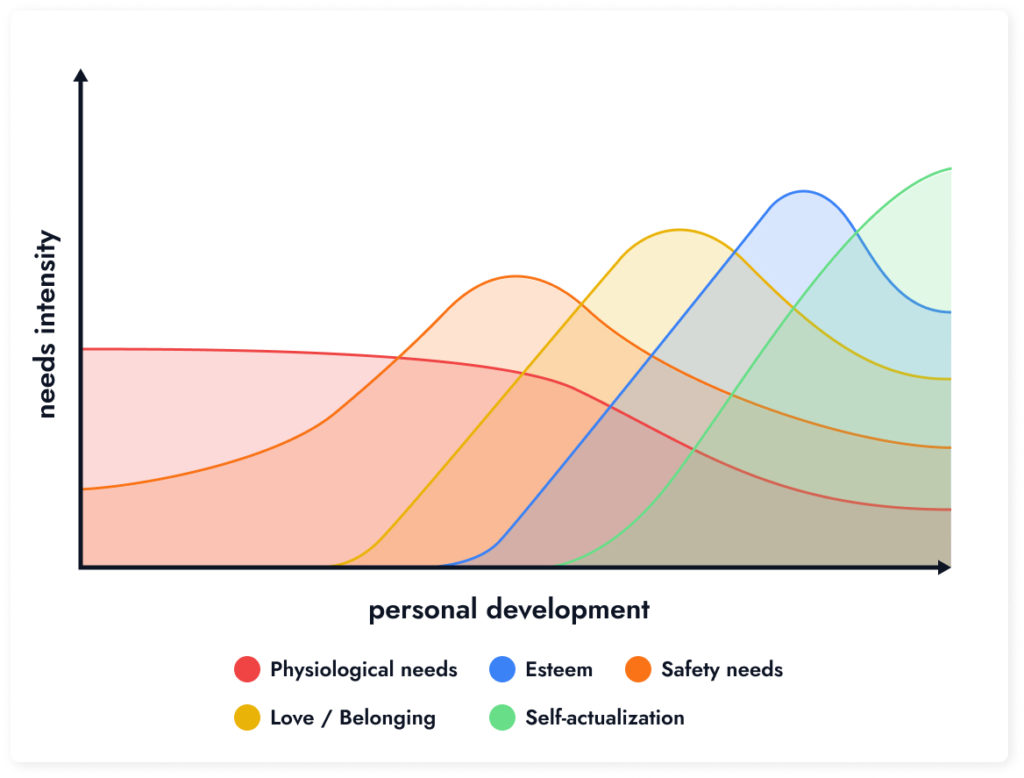Maslow’s Hierarchy of Needs in Project Management

We have all heard about Maslow’s hierarchy of needs. To put it in simple words, it describes the motivational growth of human needs. This hierarchy can be applied to many fields of business. In the following paragraphs, we will explain Maslow’s hierarchy of needs in project management and how to improve them.
Maslow’s Hierarchy of Needs
Let’s start with a simple reminder of what Maslow’s hierarchy of needs means in general. It stands for Abraham Maslow’s theory about categories of needs. Maslows created a five-tier pyramid of human needs that includes physiological, safety, love and belonging, esteem, and self-actualization needs.

Physiological Needs
Physiological needs are the main needs for human survival. Before reaching higher needs, we should satisfy primary needs like eating food, drinking water, breathing air, sleep.
Safety Needs
Safety needs include feeling safe and comfortable in the environment where we are. After our physiological needs are fulfilled, we want to have safety. Safety includes security, stability, no fear, order.
Love/Belonging Needs
Love and belonging needs mean having a need for human connection. The need for belonging makes people want to be a part of the group. The absence of socialization can cause social anxiety and clinical depression. In other words, a person has a need to find their place in the group.
Esteem Needs
Esteem needs are the needs for recognition of others. They can be fulfilled in two ways. One is mastering the task and competence. In other words, that is a desire for strength, confidence, and freedom. Another is attention and respect from others. That means status, glory, fame, and appreciation.
Self-Actualization
Self-actualization needs to stand for expressing ourselves the way we want to. After all the other needs are fulfilled, a human is intrinsically motivated to seek knowledge, peace, creating art, self-fulfillment. Therefore, curiosity and knowledge are at the edge of the pyramid.

Gradually, when all the needs are satisfied, primary needs are decreasing, and the need for self-actualization is growing.
Maslow’s Hierarchy of Needs in Project Management
In order to prevent possible troubles and delays of the project, the project manager’s duty is to recognize each team member’s motivation triggers.
Maslow’s theory describes the needs of individual person. In teams, there are many individuals whose needs should be satisfied. In order to lead the team of individuals to successful project delivery, project managers should recognize that need.
Here is important to realize that it is not useful to repeat the same motivator for people’s needs. To specify, if you already have used salary increase to motivate your employees, the other time that might not be extra motivation.

Physiological Needs in Project Management
Psychological needs in Maslow’s hierarchy of needs in project management are basic things to provide to your employees. They can simplify in these categories:
- Salary; Let your team members know their salaries.
- Comfortable place to work at; Make sure the office is clean, ventilated, and comfortable to work in. Also, there should be a suitable place for employees to eat and rest.
- No distractions at work; 54% of workers cited that they don’t perform well as they should because of distractions at work. Once when a worker is distracted, according to Gloria Mark, it takes them 23 minutes to get focused again. Encourage limiting technology for personal use and unnecessary meetings.
- Enough sleep; Don’t send tasks or email out of working time or holidays.
- Set clear goals; Everyone should know why the team needs them.
Once you have communicated these categories, the team will follow them. Every team member is provided with a place, money, and comfort. After fulfilling psychological needs, there come safety needs.
Safety in Project Management
After you fulfill primary needs, there come secondary needs in Maslow’s hierarchy of needs in project management such as safety, security, and trust. Even though it seems easy, research has shown that 1 in 3 employees don’t trust their employer. To avoid that, employees should be sure about their salary and work conditions.
Another highlight here is that employees feel safe to give feedback about the project. Also, that they are comfortable admitting their mistakes and asking for help. Some of the ways to satisfy safety needs in project management are:
- Providing the right project management tool. A tool should help team members to perform a task.
- Trust building.
- Ensure learning. If team members need new skills, organize learning for them.
Social Needs in Project Management
Love and belonging needs in a business environment are a little bit different than in private life. Even though the colleagues might be people who lack interpersonal skills, all team members should feel like a part of the team. Moreover, building trust and motivating the team are two of many soft skills project managers should have. To help your coworkers feel belonging within the team, there are a few things to do:
- Define Roles and responsibilities clearly. All team members know what is their importance in the team and the importance of other people.
- One-to-one meetings. These kinds of meetings make team members more comfortable and free to express their satisfaction.
- Celebrate small achievements and project milestones.
Esteem in Project Management
Employees are more motivated to work when they feel appreciated, both by their internal team and the external public. They are motivated when they feel competent and efficient inside their team.
Therefore, to motivate them, a project manager should show appreciation. Further, praising the successes of employees will make them appreciated. After these needs are gratified, we can expect more creativity from team members.

Another point of motivation is the external public. In other words, how employees’ company and mission are seen outside of the company. Employees who share values with their company and like their company mission are more likely to perform better.
Surprising is that only 4 in 10 people know what their organization stands for. Even worse, less than 50% can relate to their companies mission. On the contrary, 73% of engaged employees are the one who believes in their companies mission.
This shows that in other to motivate employees, they should feel both their part of work and their company are valuable.
How to improve self esteem in business environment?
– Communicate company mission. Remember that the employees should be the first customers. Therefore, for other people to like you, the employees should like you first.
– Praise your employees’ achievements. When someone does a good job, praise it in front of the team. That will be motivation for both this employee and the other team members.
– Praise the company’s growth. Share news, changes, and challenges on a higher level with your team. Being included and asked for opinions makes employees feel that they belong to the organization.
Self-actualization in Project Management
Humans have a natural tendency to express themselves in different ways. If the rest of their needs are fulfilled, there are many ways they combine their personal interests with their work. Self-actualization in project management is using creativity to improve your role at work.
The job of a project manager is to learn the interests of team members and assign them activities related to them. That can be either a certain project or factors in the life goals of the organization. Some of them can actually help employees to reach their life goals, so they feel like a win-win for employees. Some things you can do to empower it are:
– Pay attention to each employees interests
– Empower personal development and growth
Limitations of the Maslow’s Hierarchy of Needs in Project Management
Even though the hierarchy works for most people, there are some exceptions. One of the expectations is valuing religions and ideologies more than other needs. Some people prioritize their personal values over stages in the hierarchy of needs.
Second, when it comes to project managers, they often join the project after the team is already formed. That enables the project managers to assign different tasks and projects according to employees’ interests. Further, it decreases the possibility to fulfill their self-esteem needs.
In conclusion
You can’t discuss the mission and goals of your company if your employees are listening to you on damaged chairs. It seems obvious that primary needs are the most important, but still many people forget their importance. Make your team physically comfortable working, and then you can start working.
To fulfill team members Maslow’s hierarchy of needs, follow the statement “Live your values”. In other words, make your goals and purpose resonate with your team members’ day-to-day experiences. Approach your team members like the first customers of your product and watch them billing your values together.



